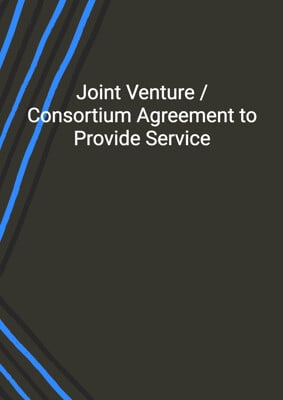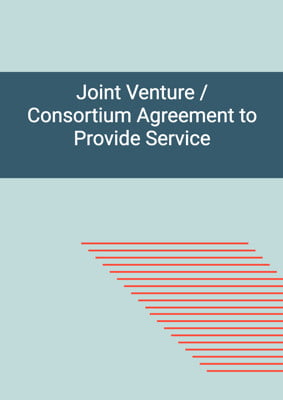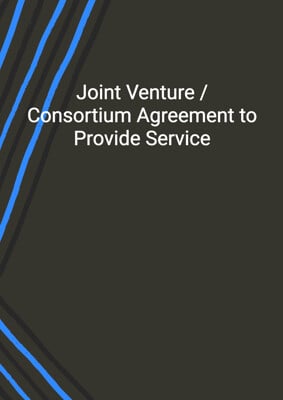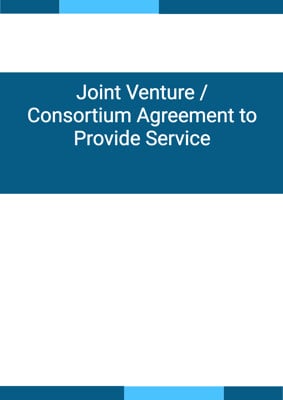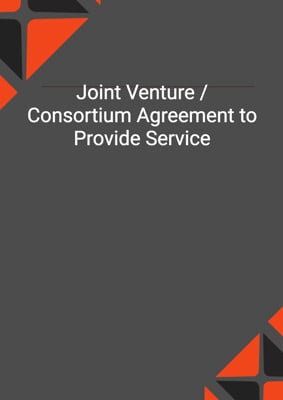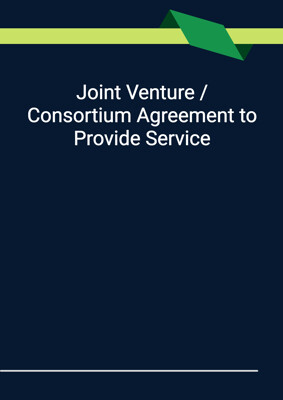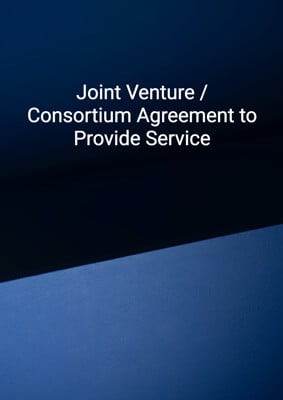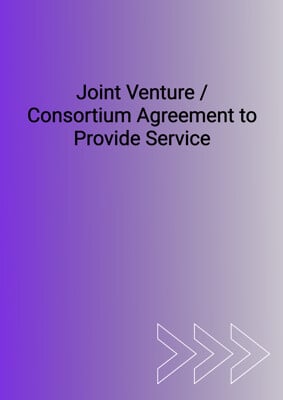How to Tailor the Document for Your Need?
01
Create Document
Click "Create Document" button and the document will be prepared with your account details automatically filled in.
02
Fill Information
Please fill in any additional information by following the step-by-step guide on the left hand side of the preview document and click the "Next" button.
03
Get Document
When you are done, click the "Get Document" button and you can download the document in Word or PDF format.
04
Review Document
Please review the document carefully and make any final modifications to ensure that the details are correct before publication / distribution.
Document Preview
Document Description
A joint venture agreement is a business arrangement in which two or more parties agree to pool their resources to accomplish a specific task. This task can be a new project or any other business activity. A joint venture can be formed using any legal structure such as corporations, partnerships, limited liability companies or other business entities.
By pooling their resources, the burden on each party can be reduced and it also allows companies to quickly enter new markets, especially foreign markets, by leveraging the established distribution networks of the partner company. Also, joint ventures can achieve greater economies of scale, as well as diversify business risks.
This checklist outlines the important considerations and steps involved in establishing a joint venture.
How to use this document?
1. Determine the right type of relationship for the joint venture, considering alternatives such as research and development/co-operation contracts, licenses or franchise agreements, distribution or agency agreements, supply of goods or services contracts, or 100% acquisition.
2. Conduct a feasibility study or prepare a business plan to assess the viability of the joint venture.
3. Establish confidentiality agreements or information exchange agreements to protect sensitive information disclosed during negotiations.
4. Consider exclusivity obligations to prevent parties from negotiating with third parties regarding competitive arrangements for a specified period.
5. Comply with stock exchange requirements and obtain necessary authorizations, consents, licenses, or other conditions precedent for the joint venture to commence.
6. Evaluate local laws and regulations in the jurisdiction where the joint venture will be established, including registration requirements, local ownership/control, local governmental consents/licenses, employment laws, taxes, land rights, intellectual property rights, and specific laws relating to joint ventures.
7. Conduct due diligence investigations into assets or businesses to be contributed by each party and consider tax and transfer duty considerations affecting the method and timing of contributions.
8. Address regulatory matters, including market share considerations, merger regulations, antitrust/competition laws, industry-specific regulatory approvals, and co-operation between parties in the event of regulatory action.
9. Consider tax implications and structuring options, including capital gain tax, capital allowances/balancing charge, tax losses, stamp duty/transfer taxes, consortium or group relief, tax-transparent structures, and international tax considerations.
10. Determine the accounting treatment of the joint venture, considering whether it will be treated as a subsidiary undertaking, an associated undertaking, or an unincorporated joint venture.
11. Address employee issues, including the transfer of a business, secondment of staff, existing share option or incentive arrangements, pension schemes, and harmonization of employment terms and conditions.
12. Establish rights and obligations regarding intellectual property, including the transfer or licensing of technology, access to intellectual property generated by the joint venture, and licensing of trademarks or trade names.
13. Draft the joint venture agreement, addressing conditions precedent, the identity of parties, the business of the joint venture entity, capital and funding, the constitution of the joint venture entity, the board of directors, shareholder meetings, matters requiring unanimity or special majority, administrative or corporate matters, profit distribution, intellectual property, restrictions on shareholders/parents, change of control of shareholders, transfer of shares, ancillary contracts, termination, deadlock resolution, and standard provisions.
14. Consider the need for pre-conditions, such as governmental or regulatory approvals, licenses, consents, tax clearances, due diligence, shareholder approvals, and long-stop dates.
15. Identify the appropriate parties to the agreement, including parent companies, shareholding subsidiaries, and the joint venture entity itself.
16. Clearly define the objectives and scope of the joint venture entity's activities, including any geographical limits or export regulations.
17. Determine the capital structure and funding requirements of the joint venture entity, including authorized share capital, equity proportions, initial investments, payment terms, shareholder loans, future finance obligations, and guarantees.
18. Establish the constitution of the joint venture entity, including the memorandum and articles of association, special rights attached to shares, pre-emption provisions, and registration requirements.
19. Define the composition and authority of the board of directors, including the number of directors, appointment rights, voting rights, chairman's role, meeting frequency, quorum, authority to bind the parent companies, and mechanisms for resolving deadlock.
20. Address shareholder meeting procedures, including quorum requirements, notice provisions, location, voting rights, chairman's casting vote, separate class rights, and proxies.
21. Identify matters requiring unanimity or special majority, such as alterations to constitutional documents, changes of joint venture entity name, capital expenditure commitments, declaration of dividends, entry into material contracts, and employment/removal of key executives.
22. Establish administrative or corporate matters, including the registered office, secretary, management information reporting, accounting records, rights of inspection, and insurance.
23. Define the principles for profit distribution, including dividend policies, minimum profit distribution levels, interim dividends, regulatory approvals, withholding tax, and special structures for dividend payments.
24. Address rights and obligations regarding intellectual property, including technology transfer, territorial scope, licenses to shareholders, training and technical assistance, and rights on termination.
25. Establish restrictions on shareholders/parents, including non-compete obligations, confidentiality undertakings, referral obligations, and parent company guarantees.
26. Consider the implications of a change of control of a shareholder, including rights to offer to sell shares, valuation procedures, change of joint venture entity name, and transfer restrictions.
27. Define the rules for the transfer of shares, including pre-emption provisions, minimum sales periods, valuation procedures, rights to sell to third parties, intra-group transfers, and put/call options.
28. Address ancillary contracts between parties and the joint venture entity, including secondment agreements, management agreements, provision of services or facilities, transitional arrangements, and intellectual property licenses.
29. Establish termination provisions, including fixed or indefinite terms, automatic termination triggers, rights to call for transfer of shares, notice of termination, arrangements upon termination/liquidation, rights to use intellectual property after termination, and division of assets and liabilities.
30. Develop procedures for resolving deadlock or breakdown, such as reference to chairmen/chief executives, casting votes, independent third parties, expert or panel of arbitrators, alternative dispute resolution procedures, and exit options.
31. Include standard provisions covering confidentiality, costs, force majeure, notices, amendments, assignment of rights/obligations, conflict resolution between joint venture agreement and constitutional documents, no partnership, interpretation, severability, entire agreement, public announcements, governing law, and dispute resolution.
This guidance provides a step-by-step approach to using the Joint Venture Agreement Checklist, ensuring that all important considerations and practical implications are addressed in the process of establishing a joint venture.
Not the right document?
Don’t worry, we have thousands of documents for you to choose from:




